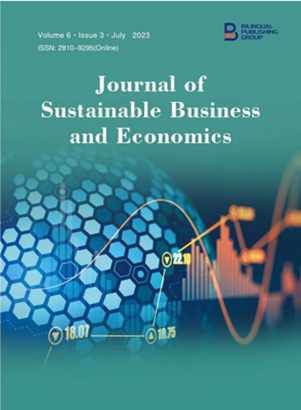-
308
-
203
-
190
-
181
-
150
Tourists' Willingness to Pay for Recreation Services in Nyerere National Park, Tanzania: Are We Overvaluing or Undervaluing Our Nature Recreation Resources?
DOI:
https://doi.org/10.30564/jsbe.v6i3.5796Abstract
This study estimated tourists' Willingness to Pay (WTP) per day for recreation services in Nyerere National Park (NNP) and compared these values with daily travel costs that are incurred by tourists to visit NNP in order to inform whether recreation resources in the park are overvalued or undervalued. The study revealed that tourists' WTP per day for recreation services was estimated at $237.4 and $1521 for resident and non-resident tourists, respectively. The estimated tourists' WTP values exceed the daily travel costs currently incurred by tourists, which are $201.04 and $1517.97 for resident and non-resident tourists, respectively. This indicates that tourists are willing to spend more to enjoy recreation services in NNP, which signifies that recreation resources in NNP are slightly undervalued. In addition, the findings disclosed that the largest share of tourist daily travel expenses is allocated to transportation services, and very little is paid to the park as a conservation fee. It was revealed that out of the daily travel expenses incurred by non-resident and resident tourists, only 4.62% and 2.23% are respectively paid directly to NNP as conservation fees. This study considers that allocation is not very fair; thus, NNP, in collaboration with TANAPA, needs to adjust the current entrance or conservation fee and reduce the transportation costs charged by tourist companies. The travel costs incurred by tourists, age, education, monthly income, site visited, substitute site, and quality of park were identified as significant factors in influencing tourists' WTP for recreation services in NNP. Thus, policies oriented to reduce tourists' transportation costs and improve the quality of national parks would attract more tourists to NNP.
Keywords:
Willingness to pay; Recreation services; Resident tourists; Non-resident tourists; Conservation fee; Nyerere National ParkReferences
[1] Malleo, J.A., Mtengwa, B.A., 2018. Role of tourism in Tanzania’s economic development. International Journal of Academic Research in Economics and Management Sciences. 7(4), 21-31.
[2] Kassaye, T.A., 2017. Estimating the recreational values of Addis Ababa Parks using the travel cost method: The case of Hamle 19 and future parks. World Scientific News. (62), 124-135.
[3] Ezebilo, E.E., 2016. Economic value of a non-market ecosystem service: An application of the travel cost method to nature recreation in Sweden. International Journal of Biodiversity Science, Ecosystem Services & Management. 12(4), 314-327.
[4] Mossie, H., Aynalem, M.A.M., 2019. Review on Economic valuation and conservation of national park of Ethiopia. The International Journal of Business Management and Technology. 3(1), 79-91.
[5] Kahangwa, P., 2018. Attitude and Perception of Tourists Towards Wildlife-Based Tourism in Tanzania: A Case Study of the Northern Tourist Circuit [Internet]. Available from: https://afribary.com/works/attitude-and-perception-of-tourists-towards-wildlife-based-tourism-in-tanzania-a-case-study-of-the-northern-tourist-circuit#citework
[6] Martinez-Espineira, R., Amoako-Tuffour, J., 2008. Recreation demand analysis under truncation, overdispersion, and endogenous stratification: An application to Gros Morne National Park. Journal of Environmental Management. 88(4), 1320-1332.
[7] Tietenberge, T., Lewis, L., 2018. Environmental and natural resources economics, 11th Edition. Routledge: New York.
[8] Nurturing Industrialization for Economic Transformation and Human Development [Internet] [cited 2020 Mar 7]. Available from: http://repository.mof.go.tz/handle/123456789/136
[9] Mufuruki, A., Mawji, R., Marwa, M., et al., 2017. Tanzania’s industrialization journey, 2016-2056: From an agrarian to a modern industrialized state in forty years. Moran (E.A.) Publishers Limited: Nairobi, Kenya.
[10] Bigirwa, D., Msese, L.R., Rwakalaza, R., et al., 2021. Measuring the economic use values of recreation resources in protected areas, evidence from Nyerere national park in Tanzania. American Journal of Environmental and Resource Economics. 6(2), 54-65. DOI: https://doi.org/10.11648/j.ajere.20210602.14
[11] Bruner, A., Kessey, B., Mnaya, J., et al., 2015. Tourists’ Willingness to Pay to Visit Tanzania’s National Parks: A Contingent Valuation Study [Internet]. Available from: https://www.conservation-strategy.org/sites/default/files/field-file/EN_discussion_paper_TANAPA.pdf
[12] Adamu, A., Yacob, M.R., Radam, A., et al., 2015. Factors determining visitors’ willingness to pay for conservation in Yankari Game Reserve, Bauchi, Nigeria. International Journal of Economics & Management. 9(S), 95-114.
[13] Gujarati, D.N., 2004. Basic econometrics. McGraw-Hill.Inc.: New York.
[14] Sofyan, S., Herlina, 2015. Tourist willingness to pay for local attractions in Sabang. IJABER. 13(7), 5677-5701.
[15] Bhandari, A.K., Heshmati, A., 2010. Willingness to pay for biodiversity conservation. Journal of Travel & Tourism Marketing. 27(6), 612-623. DOI: https://doi.org/10.1080/10548408.2010.507156
[16] Reynisdottir, M., Song, H., Agrusa, J., 2008. Willingness to pay entrance fees to natural attractions: An Icelandic case study. Tourism Management. 29(6), 1076-1083. DOI: https://doi.org/10.1016/j.tourman.2008.02.016
[17] Jurado-Rivas, C., Sanchez-Rivero, M., 2019. Willingness to pay for more sustainable tourism destinations in world heritage cities: The case of Caceres, Spain. Sustainability. 11(21), 5880.
[18] Baral, N., Stern, M.J., Bhattarai, R., 2008. Contingent valuation of ecotourism in Annapurna conservation area, Nepal: Implications for sustainable park finance and local development. Ecological Economics. 66(2-3), 218-227. DOI: https://doi.org/10.1016/j.ecolecon.2008.02.004
[19] Togridou, A., Hovardas, T., Pantis, J.D., 2006. Determinants of visitors’ willingness to pay for the National Marine Park of Zakynthos, Greece. Ecological Economics. 60(1), 308-319.
[20] Mayuri, D., 2020. Determinants of visitors’ willingness to pay for conservation of tourism resources: A study in the Nameri National Park of Assam. International Journal of Scientific & Technology Research. 9(3), 5764-5769.
[21] Mohd, P.M., Mohd, R.Y., Alias, R., et al., 2013. Willingness to pay for protecting natural environments in Pulau Redang Marine Park, Malaysia. African Journal of Business Management. 7(25), 2420-2426.
[22] Brennan, D., Tapsuwan, S., Ingram, G., 2007. The welfare costs of urban outdoor water restrictions. Australian Journal of Agricultural and Resource Economics. 51(3), 243-261. DOI: https://doi.org/10.1111/j.1467-8489.2007.00395.x
Downloads
How to Cite
Issue
Article Type
License
Copyright © 2023 The author(s)

This is an open access article under the Creative Commons Attribution 4.0 International License.




 Daudi Bigirwa
Daudi Bigirwa

